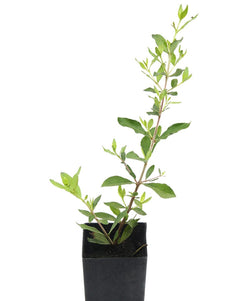
Henna
Henna

- Low stock - 9 items left
- Inventory on the way

Usually available: October to March
Life cycle: Perennial
Height: 2.5 - 6m
Position: Full sun
Soil preference: Well drained
This is how we pack and send your Herb Plants to all states except TAS & WA
You will receive
- 1 Henna Herb Plant in a 50 X 75mm tube - General growing instructions
All of our Herb Plants are grown organically with certified organic potting mixes and fertilizers
Botanical Name: Lawsonia Inermis
The name ‘henna’ is used for both the plant and the dye that is produced from crushing the plants leaves. The plant is a tall shrub or small tree, with multiple branches, growing up to 6 meters in ideal conditions. However, 2.5 meters represents a good height in many areas. The green leaves are elliptical and approximately 5 cm long by 1.5cm wide. Henna flowers are delicate and petite with four petals and elongated stamens. Although usually white, they can be red, pink or a variety of other colours depending on the variety. They white, red and pink forms have a sweet, jasmine like fragrance. The fruits are small, brown capsules with 30-50 seeds per fruit.
Henna grows wild in regions experiencing cycles of drought and monsoon rains, specifically India, Egypt, Sudan and Morocco. Generally, the native habitat of henna is the tropical and subtropical regions of Africa, Southern Asia and Northern Australasia’s semi-arid regions. The dyes from the henna plant have a long history of use in body art and adornment with early records from the Bronze Age, up to the present day in Indian marriage ceremonies and as a novelty for many others cultures. Studies show henna use in 1200 BC, on the hair and nails of Pharaohs.
Interestingly, fresh henna leaves have no fragrance, even when crushed between fingers. However, henna, when properly prepared takes on its characteristic earthy, chalky and damp smell. Usually henna is prepared by crushing the leaves and mixing the henna powder with an acidic medium like lemon juice to release lawsone, the orange-red dye.
Growing Conditions
The henna plant is well adapted for the cycles of long dry and abrupt periods of heavy rainfall found in the world’s tropical monsoon regions. The highest dye content, produced from the henna plant chemical lawsone, is produced in temperatures of 35-45 degrees Celsius, suggesting that this is the optimum temperature for the henna plant. However, the plant is cultivated in temperate regions with average temperatures of 24 degrees Celsius.
After heavy rain, the plant grows rapidly and then slows during the dry period. In long dry periods, or cooler periods, the leaves may yellow and drop off but the plant will usually recover and can be pruned to help appearances. Henna does not do well in temperatures below 10 degrees C. In temperatures below 5 degrees C, the plant will usually die. Unfortunately, henna is not well suited to areas with cool winters and frost.
In areas prone to frost, or with cooler winters, the henna plant can be grown in containers and indoors for added protection. Prepare a pot large enough to accommodate the fully grown plant and water the newly planted henna heavily. After this, do not water again until the soil in the pot has fully dried out and then water heavily again. The dry-wet cycle needs to be replicated to be successful growing henna plants. It is important not to water a little each day as you might with other plants. If the henna plant stays moist at root level then it may suffer from root rot, pests and fungal disease on the leaves. If the plant drops leaves and looks unhappy it can be pruned back to encourage recovery.
Henna prefers a sunny position and will grow in a range of soils, but does best in a light to clay loam with the ability to retain some moisture. This seems to go against the advice to let the soil dry out between watering, but does represent the type of soil common in the native habitats of the henna tree. Propagating henna is rather difficult, but the plant is grown from both seed and semi-hardwood cuttings.
Culinary Uses
The leaf has a bitter taste and is not usually used in cooking.
Medicinal Uses
Henna has cooling properties and is known to be anti-pyretic, anti-parasitic and antiseptic. Fresh leaves may be used as a topical antiseptic for fungal or bacterial skin infections, including ringworm. Henna may also be used as a gargle for mouth and gum disease and infection.
Traditional medicinal uses for henna include as a coagulant for open wounds and a poultice to sooth burns and eczema. When henna is used on the palms of hands, it helps to relax the body via the cooling effect it has on many the nerve endings found in the hands. When mixed with vinegar, henna is reputed to help cure headaches.
Henna is dangerous for people with G6PD Hormone deficiency and they should not use henna for any purpose. Some people do have allergic reactions, either to henna or to the way the paste may have been combined with other components. Note: “Black henna” and “neutral henna” are not henna as described above, but chemically developed products that can cause severe allergic reactions.
Other Uses
Henna is known for its use as a dye for hair, skin and nails. Henna has been also used to dye the manes and the hooves of horses and to colour animal skins, wool, silk and cotton - and even men’s beards.
The oil from henna flowers have also been used for many centuries as a fragrance, although this is more common in the Eastern countries.
All information provided on this website is for informational purposes only. Please seek professional advice before commencing any treatment.




